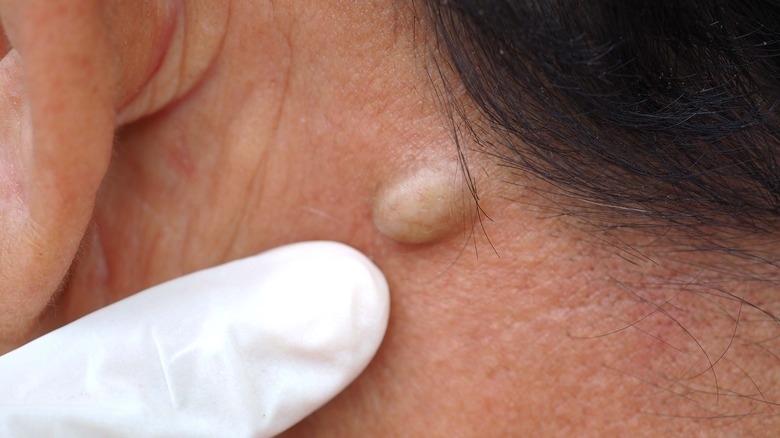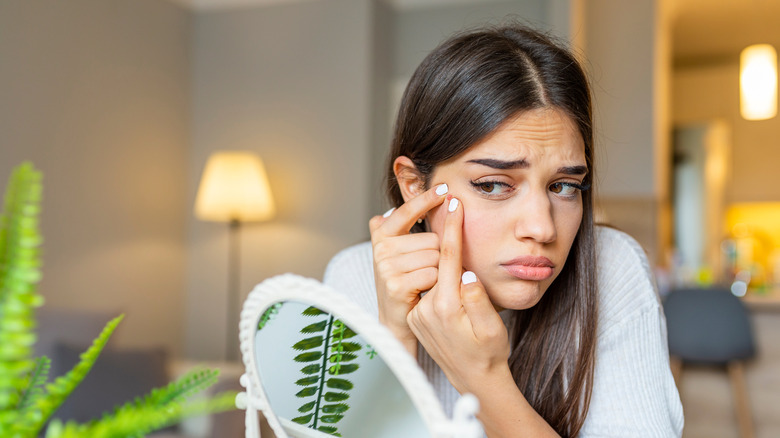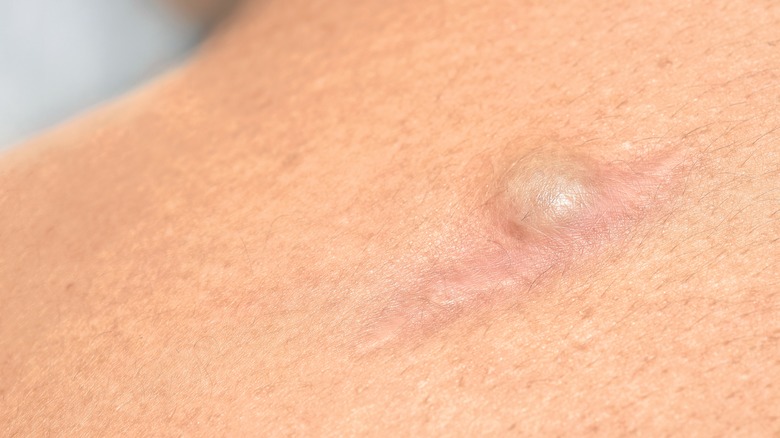Why You Should Never Pop A Sebaceous Cyst At Home
The pimple-popping craze seems to have taken over the nation, with individuals taking needles and other tools to their bumps and blemishes, all on camera. If you've scrolled through social media and seen these "popping" videos, you may wonder if you should take to the bathroom for your own blemishes. But before you gear up and sterilize your safety pins, you may want to identify if that bump is a pimple or a sebaceous cyst.
Sebaceous cysts, more commonly called epidermal, keratin, or epithelial cysts, are fluid-filled bumps or raised areas under the skin, according to Medical News Today. While they contain a sac filled with fluid, these bumps can feel a bit hard when pressed. The cysts can be small, pea-sized, or can be quite larger, depending on a number of factors, states Healthline. This variation in size can be due to the possible growth of the cyst. For some individuals, a sebaceous cyst will remain stable in size and shape. For others, however, the cyst can grow, according to Johns Hopkins Medicine. While unpleasant in appearance, sebaceous cysts are typically harmless. A few common causes of cysts are ruptured follicles (a byproduct of acne), an improperly formed sebaceous duct, or some kind of trauma to the area. Sebaceous cysts are typically found on the neck, face, and torso (via Healthline).
Why you shouldn't pop a sebaceous cyst at home
The urge to pop a sebaceous cyst can be strong, but there are several good reasons to reconsider that need to squeeze. First, according to Healthline, sebaceous cysts are encompassed in a sac. While squeezing and pressing on the bump can cause the fluid to erupt, often the sac itself remains behind. In most cases, when an at-home removal of a cyst is attempted, the sac is not properly removed, which leads to a higher risk of the cyst reforming. Additionally, according to a 2019 study published in the European Journal of Radiology Open, when the sac is not properly removed, the cells forming the sac tend to create a thicker wall when the cyst reforms.
Ensuring proper removal of the cyst by a doctor also helps to reduce the risk of infection. As with any type of open wound, puncturing or rupturing a sebaceous cyst creates an increased risk for infection (via Medical News Today). An infected cyst will often become red, inflamed, and may develop a malodorous pus. Typically, an infected cyst can be treated with antibiotics. If you suspect that your cyst is infected, please consult your physician.
Treatment of sebaceous cysts
Many individuals may be unaware of a sebaceous cyst until it becomes inflamed or infected. If you're struggling to resist the urge to puncture an unwanted protrusion that's causing you pain, know that there are a few ways that you can help to treat an inflamed or infected sebaceous cyst. Applying a warm compress to the area may help to ease the discomfort associated with an infected cyst, according to Healthline. Another important step in treating an inflamed cyst and is to keep the infected area clean. For pain, over-the-counter pain relievers such as ibuprofen or acetaminophen can help with swelling and discomfort.
If your cyst becomes inflamed, it is also important to follow up with your physician to receive proper treatment with antibiotics (via Healthline). In most cases, your physician will schedule a surgical excision of the cyst once the infection has subsided. The removal process typically consists of your doctor injecting the area with a local anesthetic, then removing the cyst with a scalpel and closing the wound with stitches. Alternatively, they may use a circular punch biopsy tool to remove the cyst more evenly.



